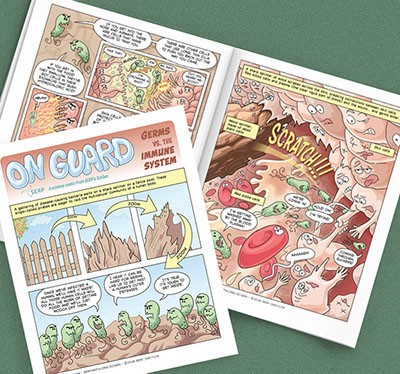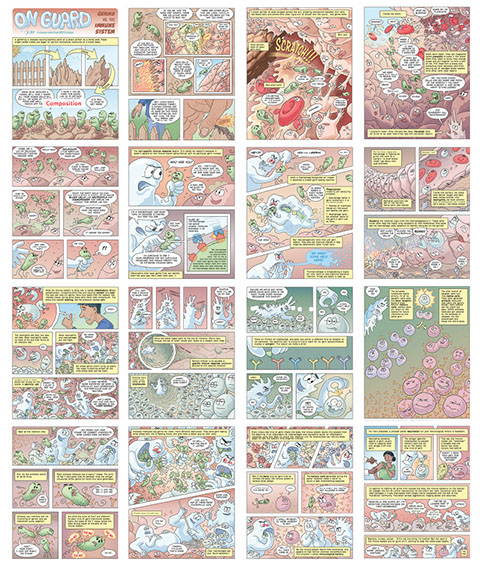SciGen Teacher Dashboard
Unit L6
Cells Teaming Up
 Reading: On Guard—Germs vs. the Immune System
Reading: On Guard—Germs vs. the Immune System
Duration: Approximately 55 minutes
This comic dramatizes how multicellular cooperation plays out at a cellular level as a cast of human cells respond to a simplified bacterial infection.
LEARNING OBJECTIVE
Students gain a basic appreciation for the multicellular approach to survival. They are introduced to the basic cells that make up the immune system and those cells' functions.
Teacher Tips
- This is a 16-page comic. It can be read on-screen or printed either as eight double-sided, stapled sheets or on four tabloid-sized sheets of paper that get folded after printing two-sided.
- Brief exposure to advanced terms like “macrophage” and “neutrophil” can stymie even the most eager students. The exact terms are not critical to what middle schoolers need to know at this stage, but they remain in the text because they help paint the big picture. Some teachers advise students to give polysyllabic terms a nickname to help them get through a text, such as "M-term" and "N-term." In this comic, you can literally give these characters nicknames, renaming the macrophage "Big Mac" and neutrophil "New Phil." For some background on the challenges using academic text in the science classroom and strategies to help limited literacy students get through texts, see the SERP site Reading to Learn in Science.
Teacher Tune-ups
- How are the trillions of cells in a human body able to cooperate?
- How do cells with the same DNA become different?
- What are some practical consequences of the fact that every cell in a human being shares the same DNA?
- Why did some organisms evolve to be multicellular?
- How are cells involved in disease?
Teaching Notes
ACTIVITY OVERVIEW
- Set the context by seeing a white blood cell in action (5 minutes)
- Read the comic (30 minutes)
- Review the story (20 minutes)
Set the context by seeing a white blood cell in action (5 minutes)
White Blood Cell on the Attack
Read the comic (40 minutes)
This is a 16-page comic explainer that deepens students' understanding of one innovative advantage of multicellular organisms: immune response. The comic dramatizes how multicellular cooperation plays out at a cellular level. Assigning different cells distinct characterizations and using humor to engage students, it depicts a simplified bacterial infection. The comic stars a cast of human cells whose behavior offers an entertaining and useful review about how cells work together for immune response when faced with an invasion by single-celled infectious opponents. In contrast, all the pathogenic bacteria in the comic are alike; they don’t use the same kind of division of labor as multicellular organisms.
Students stay on task best when reading this out loud with at least one other student.
Paraphrase:
I'll give you 40 minutes to read this comic with a partner. Take turns reading panels.
Review the story (20 minutes)
When the class finishes reading, ask students to answer these questions.
There are more comprehension questions than usual on this list. You can assign each student one or two questions or treat the nine questions as a comic scavenger hunt.
Possible answers:
- Examples of specialization by human cells in the comic could include nerve cells, macrophage, neutrophils, dendritic cells, skin cells, red blood cells, fibroblast, and lymphocytes
- Macrophages identify germs by checking cell membranes for molecules that germs would have. (Receptor cells on macrophages fit the shapes of molecules that are characterize germs.)
- The macroscopic signs of inflammation are redness, heat, swelling, and pain. White blood cells like macrophages help trigger inflammation with chemical signals. When epithelial cells that make up blood vessels get those signals, they change their shape, widening the vessels to allow more blood flow (which causes redness and heat), and allowing more fluid out into the infected area (causing swelling). The swelling causes pressure. The pressure, and also the initial chemical signs of infection, cause nerve cells to carry pain signals to the brain.
- Pus is made mostly of dead neutrophils.
- Cells communicate using chemical signals. (Nerve cells also pass electrical signals along their membrane, so that would be an acceptable student answer; but although this comic doesn’t go into detail, even a nerve cell uses a chemical signal to tell the next nerve cell to initial its electrical signal.)
- Two ways germs can do damage to the cells in people are using up their food and leaving unhealthy waste.
- Antibody molecules attach to germ surfaces. Antibodies can then interfere with germs’ functioning, make germs stick together, and encourage white blood cells to eat the germs faster.
- The immune system takes molecules from the germs themselves (antigen), and chooses a lymphocyte that makes exactly the right antibody to attack that antigen. (An antigen-presenting white blood cell like a dendritic cell helps show antigen to lymphocytes.)
- It is important for the immune system to keep a lookout in all those places because the areas where macrophages are concentrated are exactly the places where stuff from outside the body (including stuff passing through the digestive system) is most likely to get into the body. These surfaces are where germs are most likely to attack.
Respond in writing to the questions, then compare and discuss your answers with someone else.
Different kinds of human cells have different specialties; what are four examples of specialization by human cells in the comic?
How do macrophages identify germs?
What are the signs/symptoms of inflammation? What are cells doing to cause those symptoms?
What is pus mostly made of?
What's one way human cells send signals to each other? (Hint: despite the anthropomorphism of this comic, they don’t talk to each other using words!)
What are two ways germs can do damage to the cells in people?
How do antibodies help fight germs?
How does the immune system figure out what antibody to produce to fight a given kind of germ?
Macrophages patrol both the external surface of the body (the skin) and the internal “surface” (the linings of the mouth, lungs, stomach, intestines, etc.); why is it important for the immune system to keep a lookout in all those places?
BETA Version - Please send comments and corrections to info@serpinstitute.org
